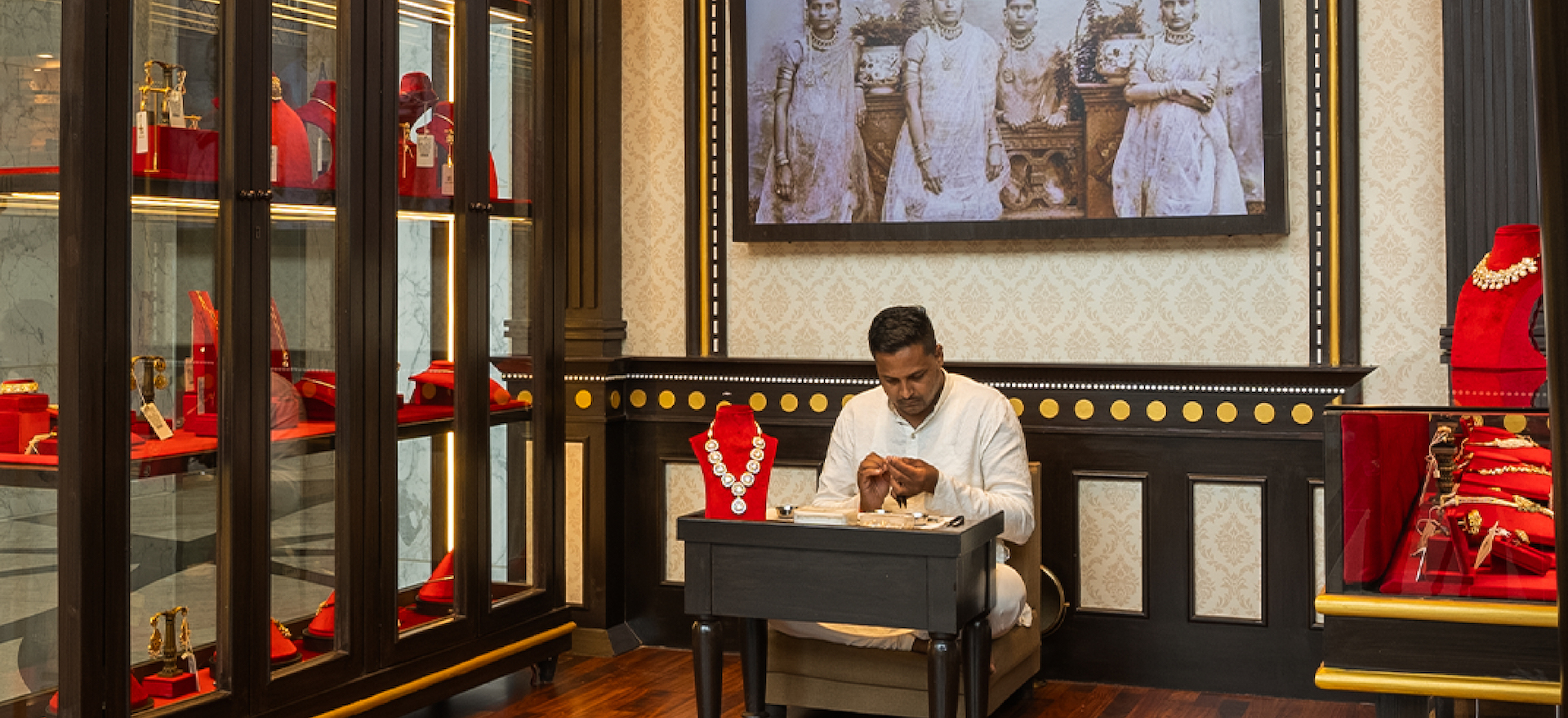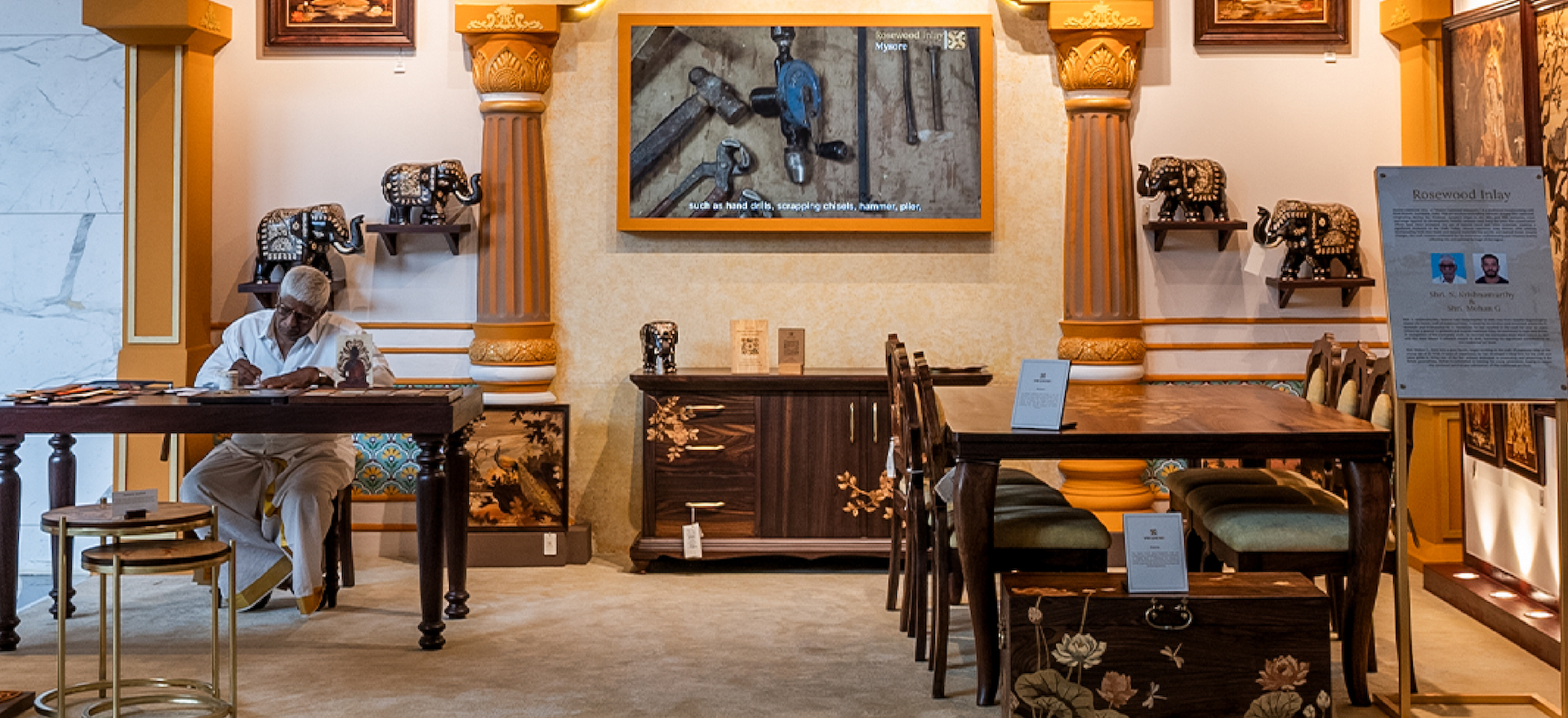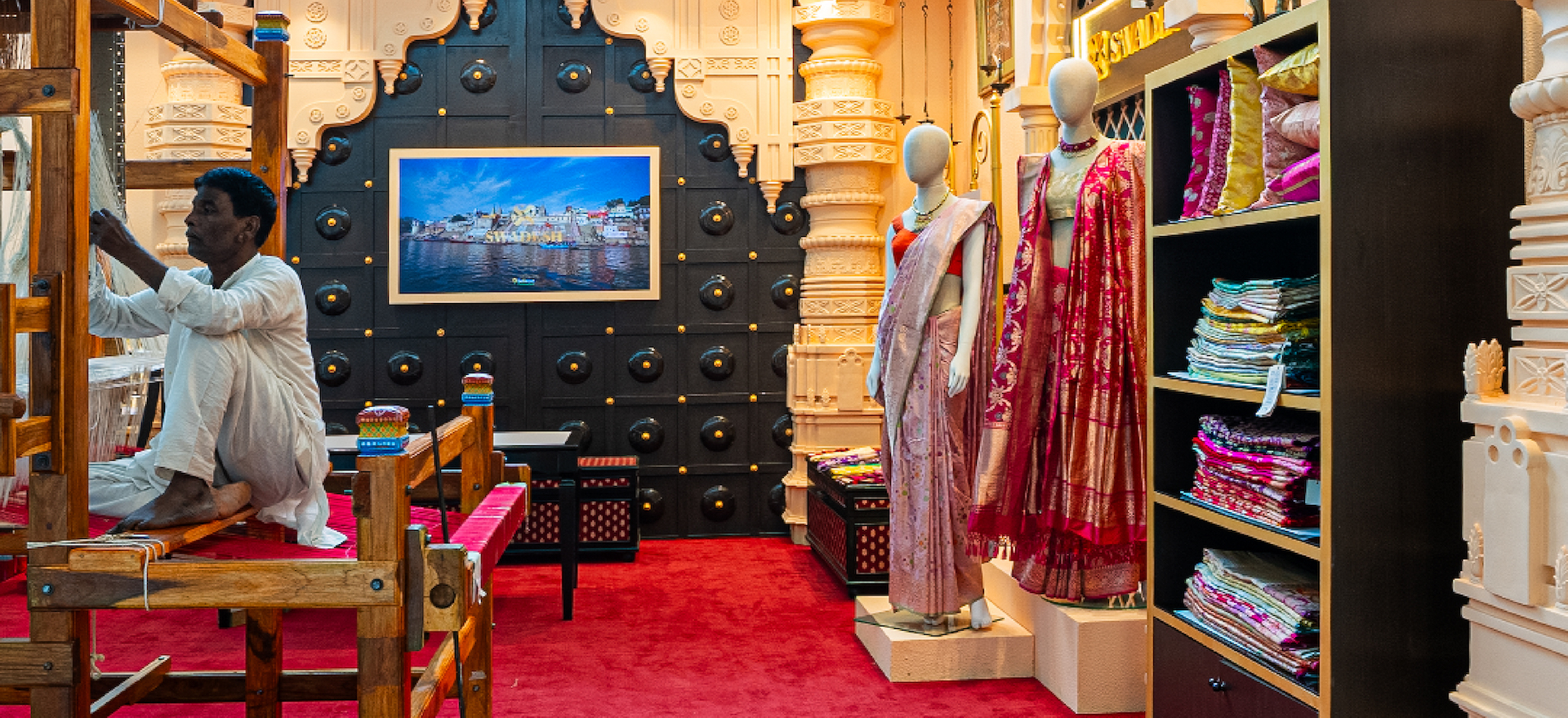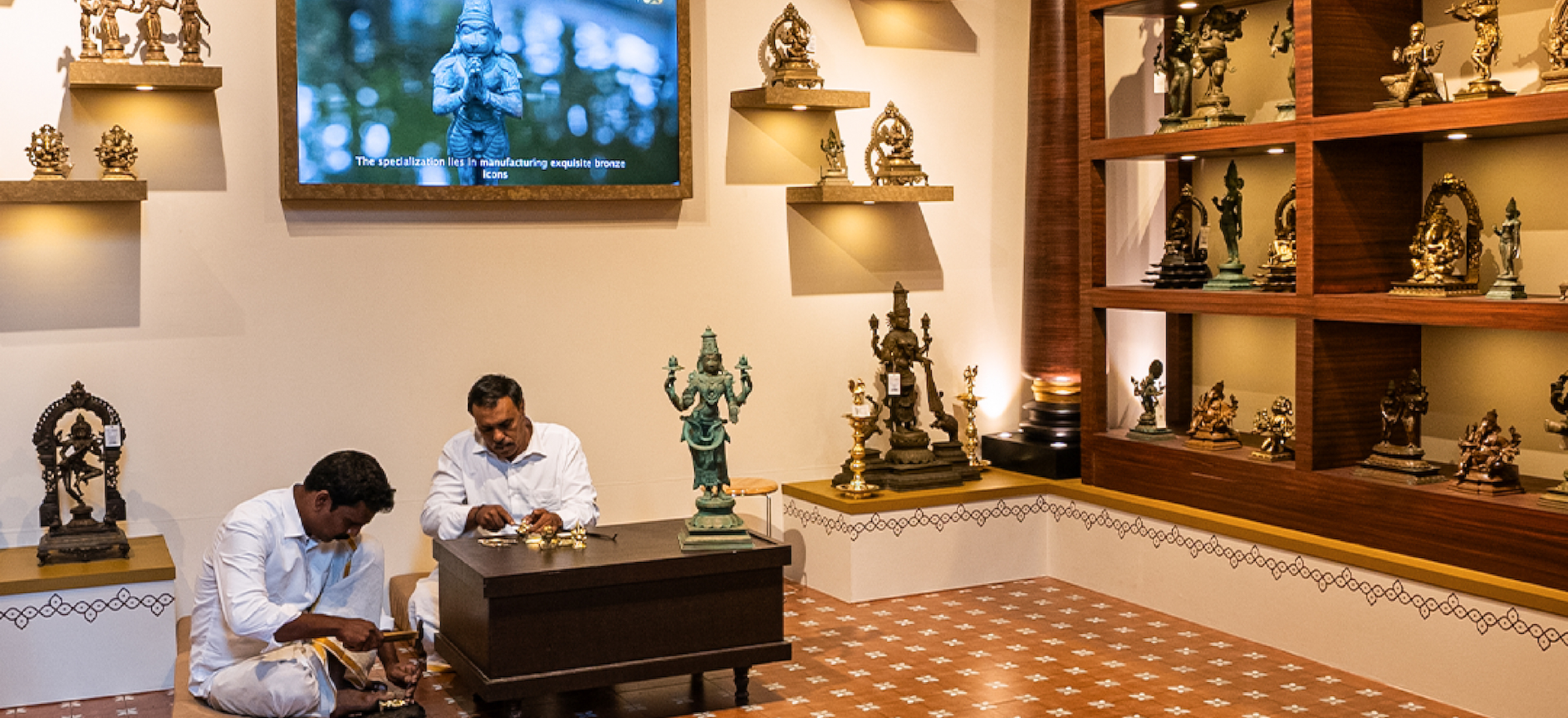
BACK TO TOP
Season’s Best: Bring in the Festivities with Vibrant New Artforms at SWADESH!
Discover colourful chronicles of Kanjivaram & Banarasi Weaves, Dank Polki Jewellery, Mysore Rosewood Inlay, and Bronze Casting at the newest SWADESH pavilions| 22nd Aug 2024
As India ushers in a long, joyful season of festivities that brighten up the later half of the calendar year, distinct works of art from local artisans will make their way to homes that are lovingly spruced up. Torans with gota patti work, handcrafted wooden mandap for Lord Ganesha and Goddess Lakshmi, or a special handloom weave to drape for Diwali – art is at the heart of all celebrations in the subcontinent. What better time to soak up some beautiful offerings at the reimagined pavilions of ‘SWADESH by Reliance Foundation’ – the Cultural Centre’s signature craft exposition that preserves and promotes diverse artforms from far-flung parts of the country!
Mirroring Mrs. Nita Ambani’s passion for the arts, ‘SWADESH’ offers a unique cultural experience. Pavilions designed to evoke the romance of the region they represent dot the Level 0 concourse area, inviting visitors on an immersive journey through India’s heritage. Along the way, they can enjoy enriching interactions with master artisans who offer live demonstrations of their craft! The sprawling alley of wonders makes for a delightful amble no matter what the season, as the showcases keep reinventing themselves to highlight newer regions and arts. Starting this August, it brings an inspiring world of treasures and tales with five new artforms – Dank Polki Jewellery, Kanjivaram Weaves, Mysore Rosewood Inlay, Banarasi Weaves, and Bronze Casting. Begin your journey with a dekko!

Dank Polki Jewellery
Inspired by the majestic interiors of Hyderabad’s Faluknuma Palace, the Dank Polki pavilion welcomes you with a regal aura of dark, wooden accents. You are looking at the centuries-old tradition of handcrafting polki or uncut diamonds into fine jewellery, through a meticulous technique that involves encasing gems in custom-made sockets, using hammer and chisel. These sockets, known as ‘dank’, are crafted from pure silver in the shape of cones. The diamonds are then secured to the dank suing special adhesive, a delicate process than requires patience and precision. Said to have flourished under the patronage of the Nizams of Hyderabad and the royals of Rajasthan, the art of Dank Polki has travelled through different eras to assume a special place in the dream trousseau of the modern Indian bride. For their part, the SWADESH pavilion comes decked with a glimmering array of earrings, neck pieces, wrist wear, and other adornments.

Kanjivaram Weaves
Kanjivaram’s is a story with deep ties to Hindu mythology. Named after the temple city of Kanchipuram in Tamil Nadu, the silk used to make the coveted Kanjivaram saree is known for its luxurious colour, design and quality of fabric. The story goes that the ‘Kanchi’ silk weavers are none other than the descendants of the sage Makaranda – master weaver of the Gods. Made using the ‘nine-yard philosophy’, the GI-tagged artform is known for carrying images of temple figurines and mythological scriptures. A special interlocking hand-weaving technique, the ‘petni’ method of joining the, and the royal shine of the three-ply silk are some tell-tale hallmarks of the saree. When it comes to the Kanjivaram, age-old customs and rituals determine which colour is worn for which occasion. Don’t believe us? Just ask the master artisans working their magic at the live handloom!

Mysore Rosewood Inlay
Nothing adds a touch of poetic grandeur to your home like some handcrafted woodwork whose artistic roots have travelled to India from 18th century Persia! A skill-intensive artform from Mysore, rosewood inlay work involves exquisite carvings on a wooden base, which is hollowed out and filled with contrasting material such as multi-hued wood, ivory shells, horn, mother-of-pearl, sandalwood, resin, or brass. Mastered by generational artisans from the region who adopted and nurtured the off-shore influence early on to make it their own, wood inlay work is typically found on paintings, furniture, jewellery boxes, decorative wall pieces, and other ornaments and artefacts. The decorative surfaces are famous for a three-dimensional effect, and often feature motifs of flora and fauna. The beloved artform, patronised by Tipu Sultan and erstwhile Maharaja of Mysore Jayachamarajendra Wadiyar at different turning points of its history, can be seen carved onto the statuesque doors of Mysore Palace. At SWADESH, it mesmerises in the forms of dining table and chair, sideboard, side table, trunks, nesting tables, and more.

Banarasi Weaves
The ebb and flow of the Ganga, lens-worthy architecture, hearty local flavours, and promises of spiritual epiphany – Banaras or Varanasi is a cultural revelation in more ways than one. Banarasi Brocade is one such cherished offering of the ancient riverine land that invites millions of pilgrims every year. Considered among the finest of Indian silk varieties, this fabric is a symbol of celebration and luxury – the result of a weaving style that demands time, effort, and dedication. The handloom used to weave these sarees are mounted with different kinds of hand-operated dobby and jacquard looms, and the entire process can take as long as six months! Embellished with characteristic designs of paisley, vine, floral jaal or butta motifs, Banarasi silk can be found in lush hues of crimson, pink, plum, green, silver, mahogany, and more – often with distinct zari borders of gold and silver. One could say there is a shade for every celebration!

Bronze Casting
Influenced by the regional handcrafting tradition from Tamil Nadu, Karnataka, and Kerala, the Bronze Casting pavilion at SWADESH beckons visitors to step into an old-world milieu of idols, sculptures, hanging bells & lamps, bhuta masks, urli, and other metallic marvels! With dainty Athangudi tiles, gleaming wooden pillars, and a backdrop fashioned from diverse elements of traditional South Indian houses, this pavilion tells the story of an artform that has been used to bring alive magnificent sculptures of Hindu deities for centuries. The art involves a multi-layered process of casting that includes creating a mold of the desired object using clay or wax, melting bronze, and pouring it into the cavity. Once the metal has cooled and solidified, the mold is removed – the final product polished to perfection by hand. Standing there, if you feel like the sculptures are a tad too life-like in poses and expressions, it’s because artisans use the techniques of engraving and embossing to create multiple depths and textures.
Influenced by the regional handcrafting tradition from Tamil Nadu, Karnataka, and Kerala, the Bronze Casting pavilion at SWADESH beckons visitors to step into an old-world milieu of idols, sculptures, hanging bells & lamps, bhuta masks, urli, and other metallic marvels! With dainty Athangudi tiles, gleaming wooden pillars, and a backdrop fashioned from diverse elements of traditional South Indian houses, this pavilion tells the story of an artform that has been used to bring alive magnificent sculptures of Hindu deities for centuries. The art involves a multi-layered process of casting that includes creating a mold of the desired object using clay or wax, melting bronze, and pouring it into the cavity. Once the metal has cooled and solidified, the mold is removed – the final product polished to perfection by hand. Standing there, if you feel like the sculptures are a tad too life-like in poses and expressions, it’s because artisans use the techniques of engraving and embossing to create multiple depths and textures.

